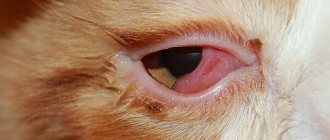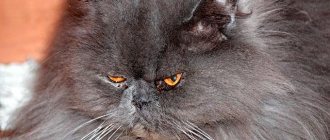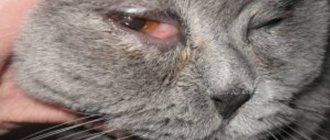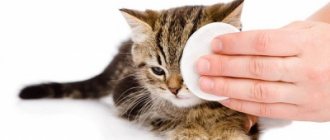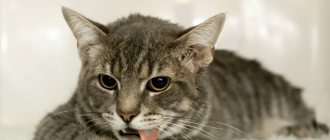Pets are more gentle than their wild relatives. Of course, street cats' eyes fester just as often - this is due to their lifestyle. But when a problem affects a well-groomed “apartment” fluffy, a caring owner will not ignore this alarm signal in any case. In this case, the desire to help and the desire to understand the situation is the first step towards alleviating the cat’s suffering and its successful recovery. After all, if a cat’s eyes fester or tears flow, it means your pet is sick. What to do? How to treat a cat in this situation? We will try to figure this out together today.
Causes and symptoms
Healthy animals also have discharge from their visual organs. As a rule, these are ordinary tears of a grayish, sometimes reddish hue. The reasons why they appear are different and there are quite a lot of them. If a cat's eyes are watery and purulent, this is not a cause for concern, especially if the discharge is rare and isolated. It is also worth considering the characteristics of the discharge. If simple tearing is normal, then the appearance of thick green or yellow pus is already an alarming sign.
First, let's figure out why a cat's eyes fester - what is the reason? After all, without understanding the cause, it is more troublesome to understand and cure the disease. Typically, these clear, watery discharges appear as a result of allergic reactions or mechanical damage. They may have a grayish or reddish tint.
Greenish or yellowish, thick, purulent discharge from a cat's eyes is considered a symptom of a bacterial or fungal infection. The disease cannot go away on its own, so these signs cannot be ignored.
Ocular and systemic diseases may be accompanied by purulent discharge from the cat's eyes. Eye diseases include:
- diseases of the cornea, eyelids;
- eye injuries;
- conjunctivitis.
Systemic diseases include chronic viral infections, panleukopenia or plague.
An attentive owner will quickly notice that the cat’s eyes are constantly festering, but in addition, the owner should be wary if the sick animal has additional symptoms indicating a problem:
- the animal looks worried, rubs its eye with its paw, refuses to eat;
- hides in dark places, body temperature may increase;
- the fur around the eye is felted and has a brown tint;
- the organ of vision is blurred and reddened.
You don't need a veterinarian's degree to understand that something is wrong with the animal. By the way, if you notice that your cat’s eyes are red and festering, redness does not have to be taken as a symptom of any illness. Most likely, this is a consequence of irritation of the eye with ichor, or the pet itself rubbed it with its paw, trying to get rid of the pain and itching that does not give rest.
When the first symptoms appear, the cat should be taken to the veterinarian in order to be correctly diagnosed and tested. To exclude conjunctivitis, the veterinarian performs a microanalysis of the cat’s eye mucosa and prescribes a comprehensive treatment. May prescribe antibiotic treatment - general therapy. For local therapy, ointments and eye drops are prescribed.
Bruise or injury to the eyelids is another important factor in the appearance of pus from the eyes. In this case, inflammatory processes are transmitted to the eyeball. You can get injured for various reasons: a fight, carelessness during the game and much more.
A cat can get blepharitis, which occurs due to traumatic, chemical, and thermal effects on the eyelids. The damaged area is an open door for germs, viruses, and pathogenic fungi that infect the eye.
Keratitis (inflammation of the cornea) is another disease that causes the cat’s eyes to fester.
Allergens – dust, perfume, pollen, medications.
There are many other reasons for the appearance of purulent discharge:
- dream;
- bad food;
- household chemicals;
- structural feature of the muzzle.
Are there any disadvantages to tear substitutes?
Manufacturers are constantly working to improve the formula of tear replacement products. Numerous studies make it possible to increase the duration of the effect, reduce the risk of side effects, etc. But even the most expensive and closest to ideal products have disadvantages:
- Temporary effect. Gels and drops that replace tear fluid moisturize the cornea and thereby eliminate the manifestations of dry eye syndrome. But with every movement of the eyelid, they flow into the nasolacrimal duct, which again leads to drying out of the cornea.
- Symptomatic treatment. Tear substitutes only work on the symptoms of sicca keratitis. But they are not able to eliminate the causes of the development of this pathology.
- Allergy risk. Allergic reactions, irritation, itching and other side effects are often caused by drops with preservatives. They can even provoke symptoms of dry eye syndrome.
In addition, using drops to relieve “sand” in the eyes and dryness is not always convenient. You will need to constantly look for a place where you can put drops in your eyes while maintaining the sterility of the procedure.
Another problem that users of artificial tears face is an increase in the unpleasant symptoms of dry eye syndrome. But why do dryness and itching become more pronounced if the drops compensate for the deficiency of tears?
The fact is that tear substitutes change the composition of natural tears due to the leaching of mucin from the conjunctival cavity. Therefore, the tear fluid becomes less viscous, unable to perform its physiological functions. Tears diluted with tear substitutes evaporate faster and the eyes begin to experience an acute lack of moisture again.
If you use eye drops with preservatives, especially when you wear contact lenses, the sensation of a foreign body in the eye will rapidly increase. This is because aggressive substances that prolong the duration of the drug destroy goblet cells (responsible for the production of mucin). This again leads to changes in the composition of tears and increased symptoms of dry eye syndrome. Preservatives can also contribute to the development of inflammation of the eye tissue. Therefore, you should not get carried away with using tear substitutes if you do not want to “acquire” new eye diseases.
Other causes of festering eyes
When the owner notices that the cat’s eyes are festering and the pet often sneezes, rubbing his nose from which snot flows, he can hardly immediately find out the cause of the sneezing and increased discharge. The same applies to the measures that need to be taken to stop the problem. Establishing the factor that caused this violation is a priority in this case.
Sneezing can be caused by ordinary dust. But if an animal sneezes constantly, this is an alarming symptom indicating illness and abnormalities in the body.
For example, if a cat has a runny nose and festering eyes, this is a common sign of a cold. It could also be an allergic manifestation to irritants or an infection.
Cat allergies are one of the most common causes of eye infections. Allergens are present everywhere:
- repellents for pests, mosquitoes, flies;
- perfume, household deodorants;
- cleaning and detergents;
- pollen of domestic plants;
- mold, fungi on the walls;
- cigarette smoke.
In addition to the main signs of allergies, such as when a cat’s eyes and nose fester, there are secondary symptoms of exposure to allergens:
- hoarse breathing;
- elevated temperature;
- general depressed state of the pet.
Each of these signs and all of them together is a reason to take the animal to the veterinary clinic. Doctors often encounter similar problems and know which antihistamine to prescribe when certain symptoms occur.
Important! It is worth understanding that if a cat’s eyes are festering due to allergies, it will not be possible to treat the problem with antihistamines. They temporarily stop the problem, but to save your pet from suffering forever, you will need to find the irritating allergen and get rid of it.
A cat's eyes fester for various reasons:
- poor health;
- reduced immunity;
- unkempt sleeping area;
- insufficiently balanced food.
Do not forget about hypothermia and drafts, because of which the cat’s eyes and snot fester especially often.
The first signs of a disease such as chlamydia are characterized by the appearance of purulent ichor and subsequent inflammation of the cornea and mucous membrane.
The next reason why a cat’s eye waters and festeres is atopic dermatitis. This is a seasonal disease of an allergic nature.
Do not discount such a factor as heredity. Cats whose family had ancestors suffering from eye diseases are at a special risk group; the likelihood of developing pathologies in these pets is 50% higher.
Sometimes it happens that the pet is apparently healthy. There are no visible symptoms of the disease, except for discharge, there are no secondary signs of infection or mechanical damage to the organ of vision. The tests also show a favorable result. Naturally, the owner of the animal has a reasonable question - why do the cat’s eyes fester if there is no reason for this.
In such cases, the answer must be looked for literally in the cat's eye. After all, the issue is most likely a congenital pathology:
- incorrectly located hair follicle;
- incorrect position of the lower eyelid;
- eyelashes in several rows;
- absence of lacrimal opening;
- lacrimal sac defect.
The animal, being a kitten, already begins to experience discomfort from the influence of the pathology, and with age and, as a consequence, an increase in the “defective area,” the symptoms become more pronounced. In our case, the cat’s eyes fester. What to do in this case is to solve the problem, usually surgically.
You cannot self-medicate; only a doctor can choose the right medications.
Why there is a feeling of “sand” in the eyes: reasons for the development of “dry eye” syndrome
Dry eye syndrome occurs in 75% of patients seeking help from specialists. The pathological condition occurs against the background of a violation of the stability of the tear film. In a normal state, the eyeball is covered by a thin film (up to 10 microns) with a heterogeneous structure. It consists of three layers:
- Lipid. Prevents heat transfer from the surface of the epithelial layer of the cornea and conjunctiva, helps prevent excessive evaporation of moisture.
- Watery. It forms the basis of the tear film and is a product of the secretion of the main and accessory lacrimal glands. Contains substances that nourish the organs of vision and are also part of the body's immune defense.
- Mucinous. The most important component of the aqueous layer, which promotes uniform distribution of moisture, has bactericidal properties. Mucins produce goblet cells of the conjunctiva, which help retain the film on the cornea.
If the tear film is not continually renewed, it becomes thin and breaks. This leads to exposure of the cornea, which in turn causes massive cell death from dehydration.
Instability of the tear film causes the eyes to feel dry and sandy, which are common symptoms of dry eye syndrome. There are many reasons for the occurrence of this pathology, both internal and external. These may be age-related changes, disruption of sleep and wakefulness patterns, and a poor diet. Often patients do not pay attention to the increase in dry eyes, which leads to aggravation of the situation.
Diagnosis
Diagnosis is available only to a qualified veterinary hospital worker after an initial examination and examination of test results. Self-diagnosis, as well as treatment, can cause serious consequences for the cat. After all, even with certain diagnostic skills, without laboratory tests you cannot be sure of the final diagnosis. Also, it is impossible to independently determine the individual tolerance of drugs during treatment.
You cannot self-medicate; only a doctor can choose the right medications.
How to treat?
Treatment of purulent eyes is primarily aimed at identifying and eliminating the cause that irritates the mucous membrane. The effectiveness of treatment procedures depends on how correctly the diagnosis is made. If it is a bruise, the damaged area is cleaned with hydrogen peroxide. In case of blepharitis, they deal with the cause that caused it. Conjunctivitis occurs - it’s time to see a veterinarian for comprehensive treatment.
How to treat a cat whose eyes are festering? Even before meeting with the doctor, the cat must be given first aid. If there is purulent thick discharge, then you need to rinse your eyes. You cannot do this without an assistant, since it is very difficult to complete this procedure alone.
Eye wash
This procedure is carried out using chamomile decoction, boric acid solution and furatsilin. 2 tsp boric acid should be dissolved in 0.5 tbsp. water, the furatsilin solution should be 0.02%. You only need to rinse with a warm solution, not a hot one. The cotton wool needs to be twisted into a tight rope, dipped into the solution and squeezed out the liquid onto the pet’s eyeball. It is recommended to carry out the procedure until the eyes become clear.
Tampons must be changed during operation; a tampon cannot be used more than once. You should not use cotton swabs, as they do not absorb liquid. To avoid injuring the cat's eyeball, do not touch it with a dry swab.
The eyes are cleared of purulent discharge; it is now recommended to apply tetracycline eye ointment (1%) under the eyelids. It is necessary to pull back the lower eyelid and coat its internal cavity with ointment with a special spatula. Then you need to close the cat's eye and massage it lightly. This will ensure the ointment is evenly distributed over the eye. It is recommended to warm the tube of ointment in your hands, so the applied product will be better distributed over the eyeball.
If the cat is nervous and resists, the ointment should not be applied, otherwise it may cause injury to the eye.
How to put drops in a cat's eyes
If your cat's eye is very sick, you can help him yourself. You won’t be taking your animal to the veterinary clinic several times a day. To ensure a successful procedure, please note the following rules:
- Lay the animal on its side and turn the pet's head up.
- If you have a rambunctious or restless cat, you may need to restrain him. A large towel or sheet is suitable for this purpose. As you understand, the animal will need to be swaddled.
- Open your pet's eye slightly and drop the medicine; if the animal shakes its muzzle, hold it with your hand, as in the photo.
After the drug gets on the eyeball, the animal, blinking, will help distribute it over the entire surface.
- Upon completion of the procedure, blot the treated area with a napkin.
The described procedures will not cure the disease, they can only relieve its symptoms. If a cat's eyes are festered, only a veterinarian can cure it. Timely treatment will save your pet's vision.
Why can feeling dry eyes be dangerous for your vision?
Dry keratitis requires timely treatment. If the stability of the tear film is not restored in time, the following consequences may occur:
- Decreased quality of life. Any usual activities (driving a car, watching TV, working at a computer) become a real test for sore eyes.
- Damage to the cornea. Violation of the integrity of the tear film leads to the appearance of ulcers, scratches, scars, and inflammation on the surface of the eye. In some cases, they undergo only surgical treatment.
- Eye infections. The tear film is made up of three layers, each of which has specific functions. So the aqueous layer provides reliable protection of the cornea from negative effects. If the stability of the tear film is impaired, it cannot resist viruses and infections.
Fortunately, there is an easy way to combat dry eye syndrome. Regular use of Delfanto® capsules in accordance with the instructions allows you to enhance the production of your own tears in a natural way and relieve dry eyes, which is caused by a deficiency of tears.
Prevention
It is necessary to prevent infectious diseases. First of all, you need to get all the necessary vaccinations for your four-legged friend. Don't forget to check on your pet from time to time. And it will never be superfluous to visit the veterinarian’s office for preventive purposes.
To avoid injury to the animal, supervise it while walking. And if your pet is prone to inappropriate behavior, walk him on a harness. Remember right away that if a cat’s eye festers after a fight, there is nothing to be surprised about. There is obvious damage to the organ by debris or the claws of the enemy. If any situation does lead to damage to the eye, do not delay with first aid, treat the affected area as soon as possible. Regarding how to wash a cat’s eyes if they fester, everything is simple - you can use boiled water or a herbal decoction.
Don’t forget about such an item as deworming. Worms cause double harm to the animal. In addition to the main parasitic factor, helminths harm the animal by poisoning it with the products of their vital activity. And if a cat’s eye is watery and purulent, this is one of the signs of an allergic reaction caused by the activity of worms.
If for any reason the animal injures the area near the eye, take measures to ensure that the pet does not scratch the affected area. An Elizabethan cat collar works well for this purpose. If desired, you can do it yourself.
If you have a long-haired cat at home that is prone to eye infections, trim the hair around her eyes - this will be a good preventive measure and a possible panacea for unwanted discharge.
In general, if you are interested in knowing why a cat’s eyes fester, first of all think about how caring you are towards your pet:
- do you vaccinate it;
- anthelmintic;
- carry out preventive examinations.
After all, timely care of the animal and care for minor injuries help to avoid many complications, including problems affecting the cat’s eyes.
Basic recommendations
We've figured out what to do if a cat's eye is seriously festering. But you should not lose sight of the basic recommendations regarding treatment and prevention, aimed at reducing the likelihood of complications. And if complications have already begun, these recommendations will help you cope with them with minimal damage to your cat’s health:
- If more than three months have passed since the last deworming, it is time to repeat the procedure. If this does not help, you should go to the doctor.
- At home, you can help your pet by making lotions with chamomile infusion or green tea before instilling the medicine.
- Do not treat cats for pus in the eyes with medications intended for humans. There is a high probability that the drug will only worsen the situation to a critical state. Only a veterinarian can prescribe “human” medications.
Veterinarian recommendations
If your kitten's eyes are festering, you should contact your veterinarian for help. Treatment depends on what is causing the condition. Having found out the cause, the veterinarian prescribes the necessary treatment, which includes:
- If your pet has swelling, then novocaine and hydrocortisone solution are used for these purposes.
- If a cat has severe pain, then he is given a novocaine blockade, which includes an antibiotic. In this way, you can not only reduce pain in the animal, but also relieve the inflammatory process.
- When the disease becomes acute and the pet feels pain, a course of antibiotic therapy is prescribed, which is preferably given by injection.
- When the cause is a bruise or a foreign body, the pet needs to use Iris or Levomycetin drops.
- Albucid, Bars, Neoconjunctivet drops help treat a condition where the eyes are watery.
- Medkinos and Lacrimin are used to wash the eyes.
If there is purulent discharge from the eyes, you should consult a veterinarian; self-medication can lead to loss of vision.
How to treat a cat's eye when injured
If a cat's eye is swollen and festering after the pet visited the street, it may be due to injury. The animal could have gotten into a fight or injured its organ of vision on a twig. Most often in these cases, people start thinking about brilliant green or iodine. What can I say - this processing is acceptable, but it can only be trusted to a qualified person. After all, these liquids, if they get on the conjunctiva, can cause a painful shock in the animal and, worse, lead to irreversible pathological processes in the eye.
The next point is what to do if the organ of vision is also swollen. If a cat's eye is swollen and festering, there is a reason for this. For example, the combination of a swollen eye and oozing exudate often indicates that a foreign object has entered the eye area. In this case, it is not advisable to help the animal “at home”. After all, you don’t know what exactly got into your pet’s eye, what if it’s a thorn that pierced the cornea. Accordingly, removing a foreign object can lead to increased damage, which will definitely harm the animal.
Inflammation of the cornea is a little more harmless. If the disease is acute, then the cat’s eyes fester greatly, in this case you already know what to do - go to the veterinarian.
Folk remedies
At home, for rinsing, it is recommended to use infusions, solutions, and decoctions prepared on the basis of medicinal herbs.
- Rinse with saline solution.
Add half a teaspoon of table salt to 500 ml of chilled boiled water and stir thoroughly. Rinse eyes 2-3 times a day with cotton pads. Do not use if the condition is caused by an allergen entering the body.
- Treatment with herbal infusion.
Prepare a mixture of dried herbs (calendula, sage) at a ratio of one to one. Pour a couple of tablespoons of the mixture into 500 ml of cold water, place in a steam bath, cook for 12-15 minutes, strain, cool. Carry out treatment several times a day.
- Washing with tea.
Pour a glass of boiling water over a bag of green tea and let it brew. Rinse the organs of vision in case of mechanical injuries, inflammatory processes to relieve inflammation.
- Treatment with solutions of furatsilin, boric acid.
Be sure to read:
The cat is breathing heavily with its stomach, does not eat: physiological and pathological reasons, first aid, treatment
Prepare a solution at the rate of: 2 drops of furatsilin per tablespoon of boiled water or a pinch of boric acid per glass of boiled water. Treat 2 times a day.

